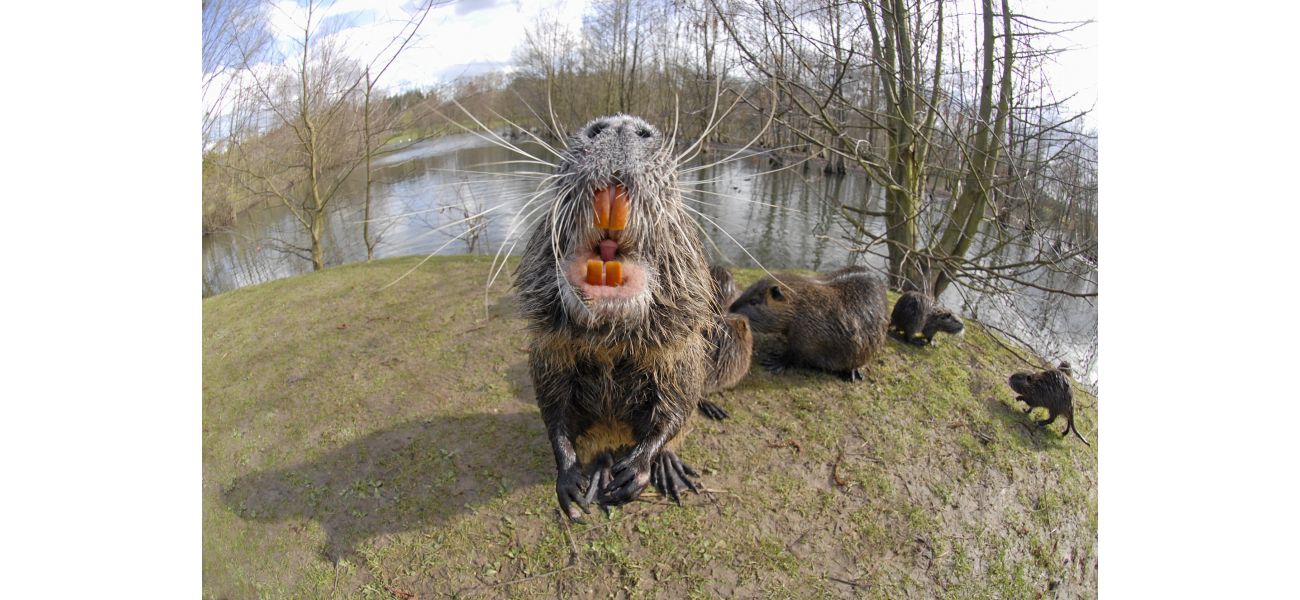California is being invaded by dangerous rat-like creatures with orange teeth. What could they be?
Tapeworms can lead to flooding and be transmitted by these creatures.
October 5th 2024.

The nutria, also known as coypu, is causing quite a stir in California as their population continues to grow. These rat-like creatures, with their bright orange teeth, are not only unsettling to look at, but they also pose a serious threat to the health and safety of the state's residents. They have been found to carry diseases such as tapeworm and tuberculosis, which they can spread while burrowing through flood defenses.
In the San Francisco Bay Area alone, nearly 1,000 nutria have been caught this year. These creatures, which can grow up to 4 feet in length, have also been spotted further up the Sacramento-San Joaquin Delta in Contra Costa County, causing concern among officials. Their burrowing and feeding habits have the potential to not only harm farm animals and household pets, but also cause flooding in the area.
Despite their "shaggy and unappealing" appearance, nutria are actually popular for their hidden undercoat, which is used in clothing. Originally from South America, these mammals were brought to the USA in the late 1800s for farming purposes. However, when the fur market collapsed in the 1940s, wild populations began to flourish, with sightings reported in at least 15 states.
To prevent their further spread, California has implemented strict controls on nutria, banning their transport or importation without permission. This is due to their invasive nature and the potential harm they can cause. Female nutria can give birth to as many as 24 young each year, with up to 8 in each litter. After only a month or two with their mothers, these young nutria will venture off on their own to feed, breed, and potentially spread disease.
According to Krysten Kellum, a spokesperson for the California Department of Fish and Wildlife, nutria can consume up to a quarter of their body weight in a day, but they also waste and destroy up to 10 times as much. This not only affects the environment, but also poses a threat to the state's economy and the safety of its residents. Their burrowing habits can cause flood defenses to fail, putting lives and livelihoods at risk.
The Department of Fish and Wildlife's website warns about the dangers of nutria, stating that they do not construct dens, but instead burrow, which can weaken structural foundations and erode banks. In addition to their disease-carrying abilities, nutria also pose a threat to pets, livestock, and nature as a whole. As a spokesperson for the department stated, their reproduction in the delta is not an option, as the threat to California's economy is too great.
In the San Francisco Bay Area alone, nearly 1,000 nutria have been caught this year. These creatures, which can grow up to 4 feet in length, have also been spotted further up the Sacramento-San Joaquin Delta in Contra Costa County, causing concern among officials. Their burrowing and feeding habits have the potential to not only harm farm animals and household pets, but also cause flooding in the area.
Despite their "shaggy and unappealing" appearance, nutria are actually popular for their hidden undercoat, which is used in clothing. Originally from South America, these mammals were brought to the USA in the late 1800s for farming purposes. However, when the fur market collapsed in the 1940s, wild populations began to flourish, with sightings reported in at least 15 states.
To prevent their further spread, California has implemented strict controls on nutria, banning their transport or importation without permission. This is due to their invasive nature and the potential harm they can cause. Female nutria can give birth to as many as 24 young each year, with up to 8 in each litter. After only a month or two with their mothers, these young nutria will venture off on their own to feed, breed, and potentially spread disease.
According to Krysten Kellum, a spokesperson for the California Department of Fish and Wildlife, nutria can consume up to a quarter of their body weight in a day, but they also waste and destroy up to 10 times as much. This not only affects the environment, but also poses a threat to the state's economy and the safety of its residents. Their burrowing habits can cause flood defenses to fail, putting lives and livelihoods at risk.
The Department of Fish and Wildlife's website warns about the dangers of nutria, stating that they do not construct dens, but instead burrow, which can weaken structural foundations and erode banks. In addition to their disease-carrying abilities, nutria also pose a threat to pets, livestock, and nature as a whole. As a spokesperson for the department stated, their reproduction in the delta is not an option, as the threat to California's economy is too great.
[This article has been trending online recently and has been generated with AI. Your feed is customized.]
[Generative AI is experimental.]
0
0
Submit Comment





